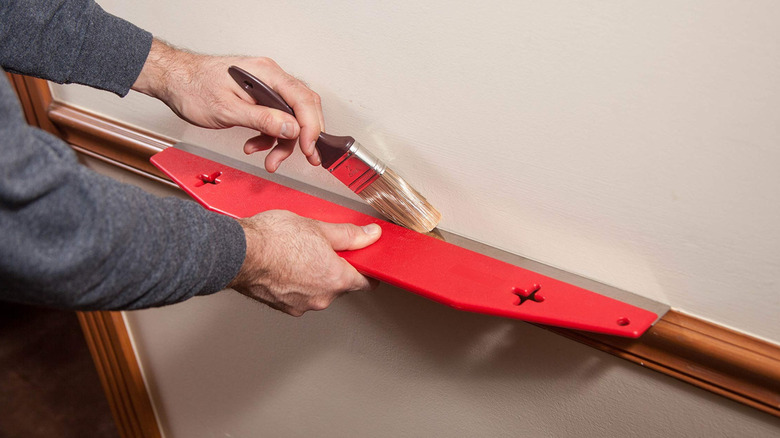The Handy Tool That Makes Painting Straight Lines A Breeze
We may receive a commission on purchases made from links.
Any kind of paint job can quickly turn disastrous around your perfectly decorated home, with splashes and sprays completely taking away from the final result. If you want to protect areas from unwanted paint, a paint guard is the perfect tool for achieving a crisp edge along baseboards, door frames, surfaces that should remain untouched from a paint job. Whether you're painting walls, cabinets, or trim, this tool makes the process just that much easier, eliminating the need for excessive taping to protect the surfaces around your paint job.
A paint guard is a simple yet effective solution for painting small surfaces, stopping paint from drifting over to unwanted areas around your home. It can reduce the need for touch-ups on a whole host of surfaces once you're finished painting. Tools like the Black+Decker 12-Inch Paint Shield work by creating a functional barrier between the surfaces around your home, allowing you to continually adjust as you paint. They provide an unmatched sense of control, allowing you to readjust as you see fit. And they are far easier to employ than painters tape or drop clothes. Unlike both, paint shields don't require a lengthy setup or cleanup process, so you can instead focus on painting your home like a professional. If your painting process requires a bit of spray paint, a larger option is available — known as a spray shield — that blocks any overspray on surfaces around your home's interior and exterior. Both types of shields can be an affordable addition to any at-home painting project that doesn't require any expertise to achieve a flawless finished result.
How to use a paint guard properly
Using a paint guard is fairly simple, but a proper trim painting technique can make a world of difference. Before you start painting, you want to ensure that your shield has been cleaned, getting rid of any residue that may be left from your last paint job. It doesn't need to be perfect but it shouldn't have an entire coat of paint on it. Angle the guard so that it is flush against the surface you are trying to protect. It should be lined up against the opposite surface of the one that you are currently painting, as this will most effectively protect it from any bleeding that might occur. If you notice a bit too much paint has built up on the edge, you can either clean your guard or flip it over to get a clean edge. Continue with this process until your entire surface has been painted, continually moving the trim guard as you paint. When the project is finished, you can revel in the crisp, spotless edges on your trim.
If you're using a spray shield for larger areas around your home, there is a simple way to cut cleanup time that can also be a clever way to repurpose old newspapers. Wrap your shield in a layer of old newspaper, taping it over the shield to protect the metal from accumulating several coats of paint. When you're finished, you can easily rip the paper off your shield and replace it with a fresh covering. This process isn't necessary when painting with a brush, though, because you shouldn't be overloading your brush with thick coats of paint.

